
by FRANCIS CALIFANO
Scenario: It is the fifth day of a statewide health emergency. There has been an outbreak of a novel virus that has yet to be identified by local or federal agencies. The Centers for Disease Control and Prevention as well as state and local health departments have issued guidance on dealing with suspected patients that are exhibiting symptoms of the virus. The major health care worker emphasis is on the use of proper respiratory protection; it is believed the virus is airborne. Use of an N-95 respirator is recommended for any suspect patient contact.
You report to work for your normal tour, and you and your partner start your normal rig check. Your top priority is to ensure you have a stock of N-95 respirators. You grab the box-which is normally full-and you find it empty. Now what? You check the supply room only to find a box with just two respirators left. Obviously, there has been a run on the respirator supply during the past week. You notify your supervisor. So, what’s next? What are your alternatives? Is there a stockpile? There are many questions you must answer.
Respiratory Protection for EMS
A respirator, technically known as a filtering face piece respirator (FFR), is defined in Occupational Safety and Health Administration (OSHA) 29 CFR 1910.134(b) as “a negative pressure particulate respirator with a filter as an integral part of the facepiece or with the entire facepiece composed of the filtering medium.” These respirators are commonly known in our industry as an N-95 respirator. Its use is intended to protect your respiratory system from airborne particulates and droplets.
Filter nomenclature is another important aspect of respiratory protection; fortunately, it is fairly straightforward. The letters in a filter specification indicate the following:
- N = Nonresistant to oil.
- R = Somewhat resistant to oil.
- P = Strongly resistant to oil.
The numbers represent the efficiency of the filter media. For example, N-95 = nonresistant to oil and 95-percent efficient. A P-100 filter = strongly resistant to oil and 99.99-percent efficient. Next, you must determine how to carry the filter. Putting all these elements together makes an air-purifying respirator (APR). As stated, it can be configured into an FFR (photo 1). It can be attached to a supporting device such as an elastomeric respirator (photo 2), a full face piece respirator (photo 3), or a power air-purifying respirator (PAPR) (photo 4).
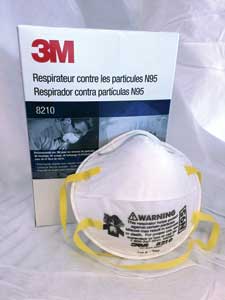 1 Photos by author. 1 Photos by author. |
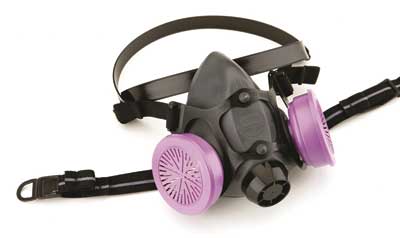 2 2 |
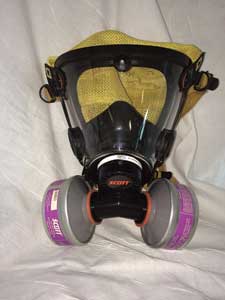 3 3 |
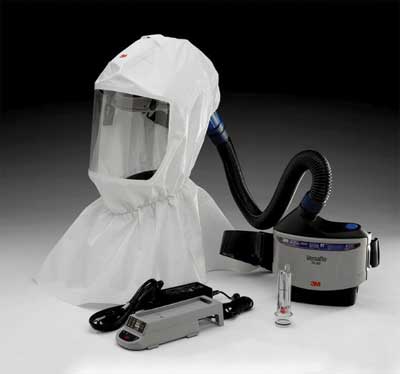 4 4 |
Traditionally, emergency medical services (EMS), like most aspects of health care, has relied on the FFR as its standard for respiratory protection; the most commonly used are N-95 respirators. Under normal conditions, these respirators are in ample supply. In recent years, there have been multiple outbreaks that have exhausted normal supply chains, sometimes for many months. They include the outbreaks of SARS in Canada and H1N1 worldwide.
So, what are our alternatives? You will need to understand the specifications and terms while looking for alternatives. First, understand the difference between a “surgical mask” and a “respirator.” Surgical masks provide barrier protection against droplets including large respiratory particles. Most surgical masks do not effectively filter small particles from the air and do not prevent leakage around the edge of the mask when the user inhales. Surgical masks are typically used to protect the environment (i.e., patient) from the wearer (i.e., health care worker) as is necessary during an open surgical procedure. In cases where EMS workers suspect an airborne transmitted illness, they place a surgical mask on the patient to protect themselves (and others) who are in the vicinity.
What Works Best?
When confronted with a supply shortage as described, incorporating an APR adapter to your existing self-contained breathing apparatus (SCBA) face piece with the appropriate filter medium may be a simple, economic fix (photo 5). Elastomeric respirators are another inexpensive alternative and may be readily available from a local industrial supplier. Once the basic respirator is issued, you need only replace the filter cartridge when it reaches the end of its service life, so consider having a supply of replacement filters. Remember, the introduction of any new style respirator other than styles you currently use will require fit testing in accordance to OSHA 29 CFR 1910.134; this standard states that you must be fit tested for the exact make and model respirator you intend to use. The paragraph on fit testing requires that, before an employee may be required to use any respirator with a negative- or positive-pressure tight-fitting face piece, the employee must be fit tested with the same make, model, style, and size of respirator that will be used.
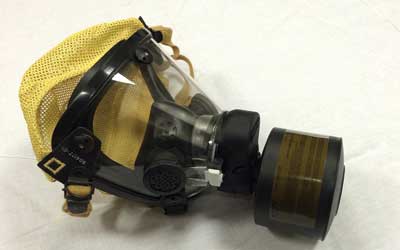 5 5 |
Just because a respirator has the “N-95” designation does not mean it is universal. Each specific manufacturer’s mask would have to be fit tested to the health care worker. For example, a 3M 1820 is not the same as a 3M 9105. A way to overcome this requirement would be to eliminate the need for fit testing such as using a PAPR. The major drawback to using a PAPR is cost, which averages from $750 to $1,000 each. As you can see, there are several options for filling the gap when respirator supplies are short. Finding what works best for you will depend on what resources you have available.
Playing by the Rules
Your department should have a comprehensive respirator protection plan (RPP). This plan is often driven by the use of SCBA by firefighters. It should include using respirators during patient-care scenarios. Components of your respiratory protection plan should include the following (reference OSHA 29 CFR 1910.134):
- Scope. To whom does this plan apply, what is its intent, and under what circumstances is the use of a respirator required?
- Medical evaluation. All personnel who are or may be required to wear a respirator in the course of the performance of their duties are required to have been medically cleared to use a respirator.
- Approved respirators. This is a list of specific manufacturers, styles, and types of respirators approved for use under this plan. This list should include any respirators being considered in the event of a supply shortage of currently used respirators.
- Training. Training must be conducted on the specific respirator to be used. This includes proper donning and doffing, proper fit/sealer check, and care and maintenance. This training can be “just in time” training on issuance of the respirator.
- Fit testing criteria. All respirators defined in your RPP must be properly fit tested in accordance with OSHA 29 CFR 1910-134 Appendix A. Either qualitative (QLFT) or quantitative (QNFT) fit testing may be used. Qualitative fit testing is done by having the user don the specific respirator. A hood is then deployed over the user’s head, and an irritant is introduced such as saccharin or bitrex. This will test the “quality” of the respirator’s fit. QNFT is done by using a condensation nuclei counter (CNC), which counts ambient air (outside the respirator face piece) to air inside the respirator face piece. Candle smoke is often used to aerosolize particulates into the air. The CNC compares the ambient air particulate count to the particulate inside the mask, “quantitatively” assessing the respirator’s fit. Test all tight-fitting/full-face respirators such as SCBA face pieces this way.
- Care and storage guidelines. Outline the instructions for the care and storage of the specific respirators used in your RPP. This includes “end of service life.”
- Record keeping. Detail the methods of record keeping in your RPP.
- Plan review. Your RPP should include a schedule of review and update procedures.
Address in your plan how to conduct respirator fit testing and who is qualified to perform such testing. Medical clearance is required before any personnel are permitted to use a respirator. This medical clearance must be completed by a physician or other licensed health care professional (per OSHA) using a “medical questionnaire” as described in OSHA 29 CFR 1910.134, Appendix C. Once a person has been medically cleared, you can conduct fit testing with the appropriate respirator. The person conducting the fit testing needs no specific certification or medical/nursing license. The OSHA standard states that the person conducting the fit test must be familiar with the proper use of the specific respirator being tested. The test “subject” should demonstrate the proper donning technique and perform a “seal check.” The person conducting the fit test should correct any shortcomings to ensure user competency. The fit test is then conducted using either QLFT or QNFT testing methods.
Planning for a Shortage
A well-designed plan may consider all or some of these alternatives. Every fire department and EMS group should strongly consider creating a stockpile of several styles of respirators. In your planning, consider forming a local or regional cache of respirators to be shared in the event of a shortage. Knowing the structure of your RPP will assist you in choosing an appropriate alternative. Planning in advance will make a transition more manageable. Do not attempt to acquire samples and evaluate their pros and cons while under time constraints. Once you establish applicable alternatives, integrate them into your respirator protection plan.
REFERENCES
www.cdc.gov/NIOSH/docs/2013-138/pdfs/2013-138.pdf.
www.osha.gov/SLTC/respiratoryprotection/training_videos.html.
www.publichealth.va.gov/docs/cohic/project-breathe-report-2009.pdf.
FRANCIS CALIFANO, BS, EMT-P, CHSP, is an emergency management coordinator for North Shore-LIJ Health System, Population Health in Manhasset, New York, assigned to the Occupational and Environmental Medicine of Long Island. He is a 30-year member and a company safety officer for Rescue Hook & Ladder Co. #1 in Roslyn, New York, where he also served as captain of EMS. Califano has a bachelor of science degree in community services/emergency management from the State University of New York-Empire State College. He has been a speaker at the FDIC and other national conferences. Califano is a certified hazardous materials specialist and a certified health care safety professional.
More Fire Engineering Issue Articles
Fire Engineering Archives
Ran in the January 2015 issue, Volume 168, Issue 1.

